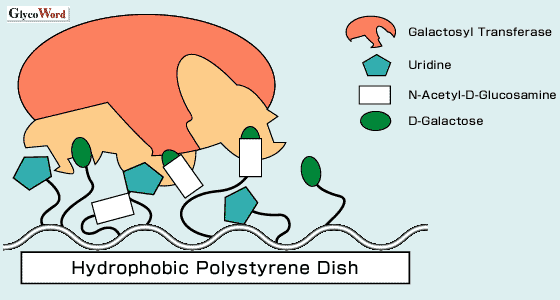|
Bioinspired Material Having Nucleoside and Carbohydrate
|
|
|
 |
It is well known that glycosyltransferase exists in endoplasmic
reticulum or Golgi apparatus, and catalyzes the glycosyl transfer reaction
from a glycosyl donor (sugar nucleotide) onto a glycosyl acceptor (alcohol
such as carbohydrate). Therefore, a glycosyltransferase has three kinds
of substrate specificity. One for the sugar unit which is transferred,
one for the alcohol which accepts the sugar unit, and one for the nucleotide
residue of the glycosyl donor. Recently, it was reported that a glycosyltransferase
exists not only in the organelle of the cell but also on the cell surface,
and the function of the cell surface enzyme is of interest. On the cell
surface, there are many kinds of molecular recognition sites which work
in cell adhesion, cell proliferation, cell movement, and so on. A kind
of receptor on the cell surface recognizes the carbohydrate chain. In
this article, cell adhesion through specific recognition of cell surface
glycosyltransferase is reported.
In the case of cell adhesion through a recognition site, molecular clustering
on the cell surface and the resulting multiple interactions are quite
important. Therefore,clustering of the adhesive molecule which is recognized
by glycosyltransferase is necessary for the specific cell adhesion through
glycosyltransferase. Clusters of adhesive molecules are a kind of bioinspired
material. Among the aggregated materials such as micelles, liposomes,
and dendrimers, the random polymer is the most suitable substrate for
cell adhesion because of its ease of preparation, ease of immobilization
on the solid surface, diversity of shape, and difficulty of phase separation.
3T3-L1 fibroblast has galactosyltransferase on the cell surface which
recognizes D-galactose, N-acetyl-D-glucosamine, and uridine.
As the bioinspired material, the polystyrene dish was coated with the
substituted polystyrene having D-galactose, N-acetyl-D-glucosamine,
and uridine1).
By seeding 3T3-L1 fibroblast on the polymer-coated dish, specific interaction
between the cell and the glycopolymer can be observed (Figure).
|
|
|
 |
|
|
Among the three kinds of recognition molecules,
uridine is the most strongly related to cell adhesion2).
3T3-L1 fibroblast is a good adhesive specifically on the dish coated with
a uridine-containing polymer. On the other hand, it does not attach to
the surface of polymers having galactose or glucosamine. However, it dose
attach to a glucosamine-containing polymer in the presence of a soluble
uridine derivative. Thus, cell adhesion through cell-surface glycosyltransferase
is controlled by three kinds of different recognition molecules. In the
future, the control of the spatial arrangement of the three kinds of biofunctional
groups (two kinds of sugars and one kind of nucleoside), will enable the
cells to show the maximum function, and its related gel may work as an
artificial extracellular matrix and/or the basement of a biosystem construction. |
|
|
|
Kenichi Hatanaka
(Institute of Industrial Science, University of Tokyo) |
|
|
|
|
| References |
(1) |
K. Hatanaka, H. Takeshige, and T. Akaike, J. Carbohydr. Chem.,
13, 603-610 (1994). |
|
(2) |
K. Hatanaka, J. Oishi, A. Tsuda, S. Matsunaga, M. Kunou, Y. Yachi,
M. C. Kasuya, and T. Okinaga, Macromol. Biosci., 1,
397-400 (2001). |
|
|
|
|
|
| Apr. 1, 2003 |
|
|
|
|
|
|
|



